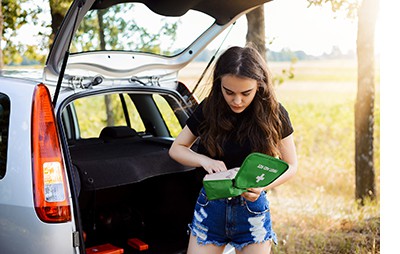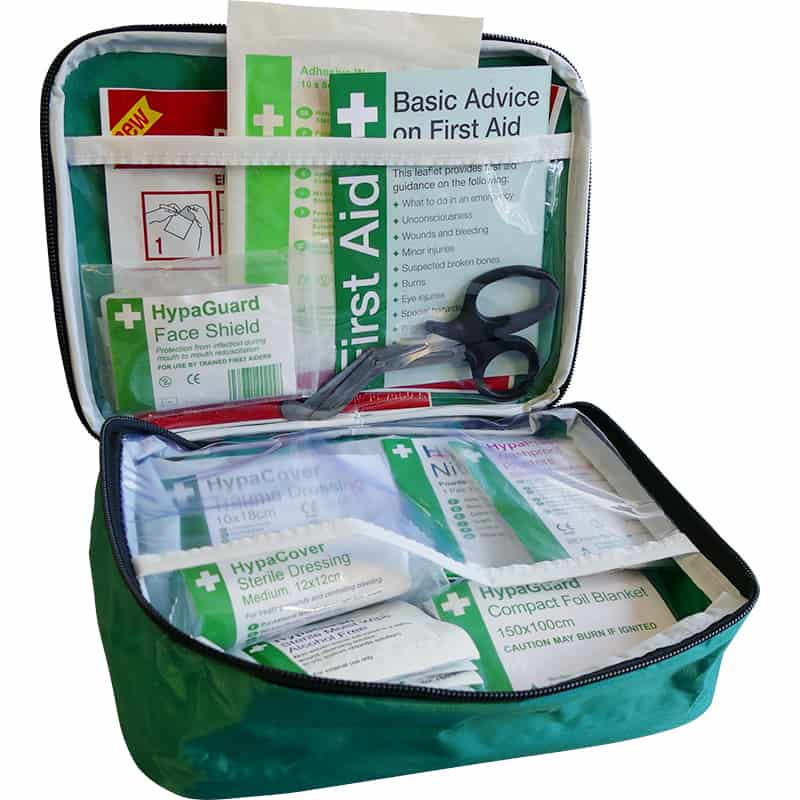
Why you should have a first aid kit in your car
The road is a risky place. Even the best drivers can find themselves involved in an accident. Thankfully, the number of road casualties each year is going down, however, there were still 135,480 road casualties in 2022, with 1711 fatalities.A significant proportion of injuries caused by road accidents are serious. A first aid kit could save someone’s life and help lessen the impact of injury until the emergency services arrive. At the very least, a first aid kit will provide comfort and relief to people with less critical injuries. Should you be involved in or witness an accident, a first aid kit will empower you to help yourself, your passengers and others.
The benefits of having a first aid kit in your car aren’t limited to road accidents. Having a first aid kit in your car means that you are always prepared to treat wounds while you are travelling. Just knowing that you have first aid provisions nearby can be a source of great comfort, particularly on adventurous days or family days out with children, who are more prone to minor injuries.
Vehicle first aid kit essentials
You can put any first aid kit in your car, though it is advisable to have a kit which covers all the basics without taking up too much space. Our Car & Vehicle First Aid Kit comes in a compact soft Nylon case and includes everything needed to treat minor wounds. However, if something more substantial is required, our British Standard Motoring First Aid Kit comes in a hard plastic case and includes a trauma dressing which is more suitable for serious injuries such as severe wounds.
The British Standard BS 8599-2:2014 guides the size of first aid kits recommended for cars, dependent on the number of passengers. There is separate guidance for Public Service Vehicles, including commercial passenger-carrying vehicles and taxis – please see the section on this below. In addition, BS 8599-1:2019 also suggests that employers provide a medium-sized kit for workers who travel or drive as part of their role:

Is it a legal requirement to have a first aid kit in your car?
 In UK there’s no legal requirement to have a first aid kit in a personal car. However, many drivers choose to carry one so that they are prepared for any situation. Kits, such as the Car & Vehicle First Aid Kit provide a comprehensive range of first aid supplies to allow you to treat common injuries on the go. In addition, the First Aid Guidance Leaflet included in this kit ensures you will have the necessary information in an emergency.
In UK there’s no legal requirement to have a first aid kit in a personal car. However, many drivers choose to carry one so that they are prepared for any situation. Kits, such as the Car & Vehicle First Aid Kit provide a comprehensive range of first aid supplies to allow you to treat common injuries on the go. In addition, the First Aid Guidance Leaflet included in this kit ensures you will have the necessary information in an emergency.
If you are driving abroad, be aware that some European countries have laws which require drivers to carry first aid kits. Always check government guidance for the country that you are travelling to and be prepared with kits such as the Din 13164 European Motoring First Aid Kit.
Should you carry a first aid kit if you drive for work?
If you’re required to drive as part of your job, it’s recommended that you have a first aid kit to meet health and safety guidelines relating to the provision of first aid.
Self-employed workers are advised to assess the hazards and risks of their workplace, which may identify the need for a personal first aid kit if the work involved continuous road use or driving long distances as this may increase the chances of there being an injury.
Employers must include lone workers in their risk assessment, and ensure any lone workers are suitably provided for with first aid supplies and training, if necessary. Examples of lone worker driving roles could include the following:
- Health, medical and social care workers visiting people’s homes etc.
- Engineers, assessors and delivery drivers of equipment and supplies who attend construction projects
- Service workers, including postal staff, taxi drivers, engineers, estate agents, and sales or service representatives visiting domestic and commercial premises
- Delivery drivers including HGV drivers, van driver/couriers and car/bike-based couriers
- Agricultural and forestry workers.
In addition to this, employers must consider newer types of lone workers, for example those working in the gig economy, such as on-demand taxi or delivery services obtained through an online platform and delivered on a task-by-task basis.
The British Standard Workplace First Aid Kit guidance (BS 8599-1) was updated in 2019 to include Travel and Motoring first aid kits that matched the BS 8599-2:2014 guidance for medium motor vehicle first aid kits (see table above).
Public Service Vehicles
 If you operate a public service vehicle, sometimes referred to as a commercial passenger-carrying vehicle, such as a taxi, minibus or coach, your vehicle must carry a first aid kit according to The Public Service Vehicles (Conditions of Fitness, Equipment, Use and Certification) Regulations 1981 and The Road Vehicles (Construction and Use) Regulations 1986.
If you operate a public service vehicle, sometimes referred to as a commercial passenger-carrying vehicle, such as a taxi, minibus or coach, your vehicle must carry a first aid kit according to The Public Service Vehicles (Conditions of Fitness, Equipment, Use and Certification) Regulations 1981 and The Road Vehicles (Construction and Use) Regulations 1986.
The minimum required first aid equipment for such vehicles are listed below although, as always, employers are expected to complete a full risk assessment to identify any additional needs:
- Ten antiseptic wipes, foil packed
- One conforming disposable bandage (not less than 7·5 centimetres wide)
- Two triangular bandages
- One packet of 24 assorted adhesive dressings
- Three large sterile unmedicated ambulance dressings (not less than 15·0 centimetres × 20·0 centimetres)
- Two sterile eye pads, with attachments
- Twelve assorted safety pins
- One pair of blunt-ended scissors
In addition to providing the above first aid supplies, they are required to be kept in a receptable that is suitable, maintained in a good condition, readily available for use and prominently marked as a first aid receptacle or first aid kit.
What about first aid for other vehicles?
First aid for motorbikes
If you ride a motorcycle, we also highly recommend that you take a first aid kit, whether in a small backpack or in bike luggage. According to government statistics for 2020 motorcyclists, who fall into the “vulnerable road users” group, had the highest road user fatality rate per billion passenger miles. In 2020, there were 13,604 reported road casualties for motorcyclists.
These are sobering statistics, which is why first and foremost, you must wear adequate safety equipment when you’re riding a motorcycle. Our British Standard Motorcycle First Aid Kit comes in a variety of containers. You may wish to also consider a Critical Injury Pack, particularly if you’re riding as part of a group.
First aid for motorhomes
If you are travelling in a motorhome, it is likely that you are embarking on a longer journey. Of course, the same first aid kits listed above will be helpful for you, but you may also want to consider any additional supplies you might need for a longer trip, such as a wind-up torch, snaplight and a comprehensive burns kit, if you are planning on cooking.
If you are travelling abroad, you may be required by law to carry a first aid kit such as Din 13164 European Motoring First Aid Kit.
First aid for HGVs and LGVs
If you drive an HGV or LGV, it is likely that you are doing so for work. Therefore, a risk assessment should have been completed in which your needs, the vehicle-type and journey-type have all been considered. It is highly likely that this will result in identifying a need for a first aid kit that complies with BS 8599-2:2014 for medium vehicles (see table above). This would mean that your employer was complying with BS 8599-1:2019, which includes a suggested kit for travel and motoring for work.
Regardless of where, how and why you are on the road, make sure you understand exactly what you need and that you have the necessary first aid kits and equipment to provide effective first aid wherever you are.
Read our blog for more information on first aid, or contact us for further advice and information on our products.






